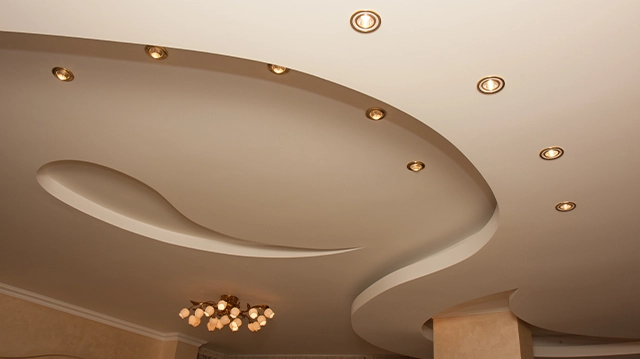Curved Gypsum Board Ceiling installation contributes to beautification in interior office design, which gives a a sleek look for workspace, modern look and beautifies the functional and aesthetic perspectives of the place. But how does this visually interesting feature construct and what are the technical considerations for the same?
1. Planning and Design
Detailed planning comes first, in which designers and contractors map out the shape, the angle and how the curve aligns with the rest of the office design. Further, they are supposed to take into consideration the ceiling in its relation to lighting, HVAC and other structural components.
2. Choose the Right Materials
Choose the right gypsum board for the job. For curved designs, contractors like using flexible or thin gypsum boards. These are able to bend without fracturing the material or a lot of damage. Standard gypsum boards are typically 12.5mm thick, but when it comes to curves, contractors often use boards in the range of 6-9.5mm thick. This creates flowing, elegant curves without loss in durability.
3. Framework Construction
The first thing that needs to be done before putting the gypsum boards up is to provide a solid and correct framework. Generally speaking, the use of metal framing is the most common choice due to its strength and flexibility. Essentially, the frame is made from galvanized steel or aluminum profiles that are just bent into the desired curvature. The installation team carefully measures and bends the metal profiles to ensure that the curvature is even and the structure will be solid.
This has to be secured to the primary ceiling joists or an existing structure by using metal fasteners and brackets so that the curve is stable enough to carry the weight of gypsum boards.
4. Gypsum Boards Bending and Installation
The Curved Gypsum Board Ceiling requires technical skill in the installation, especially bending the gypsum boards. The boards may slightly be wetted so that they become flexible and easily bent to shape. The boards are then fixed onto a pre-constructed metal framework using drywall screws and adhesive.
At this stage, the curvature is to be closely monitored for consistency. Besides, a smooth, seamless appearance is one of the essentials that can make the ceiling visually appealing; misalignment should, therefore, be kept from interfering with it entirely.
5. Joint Treatment and Finishing
After securing the boards, the joints are covered with joint compound or filler to begin rendering it a smooth surface. This parabolic surface should be seamless, continuous, so multiple thick layers of filler may be applied and sanded to achieve the glossy finish. The surface being perfectly even, the ceiling can now be primed and painted as desired for the office space.
6. Technical Consideration for Accommodation of Lighting and HVAC
Another problem with arched ceilings is the integration of lighting and HVAC. Recessed lighting installation is very common since it can easily fit into the ceiling without spoiling the curve. Similarly, air vents and HVAC are to be designed very carefully to follow the curvature in such a way so they may not interfere with the view of the ceiling yet serving the purpose.
7. Acoustic and Thermal Insulation
This is also where, particularly for office settings, gypsum board ceilings improve sound and temperature controls. Acoustic panels or insulation materials can be fitted behind the gypsum boards, thereby enhancing sound absorption and keeping the space quieter. This is very useful in open-plan offices where the level of noise is high.
Apart from that, the gypsum ceiling services can allow for thermal insulation materials to be installed so as to attain temperature and energy efficiency in the office.
8. Advantages of Curved Gypsum Board Ceiling
The functional role that a Curved Gypsum Board Ceiling can play in the office, besides its beautiful looks, is difficult to deny. It gives the room an airy and lofty height, making it much larger than it actually is. Seamless curves give it a very modern and sophisticated look that can impress any client or visitor for years to come. This would, on the other hand, facilitate better lighting distribution in the room due to the curvature that helps in dissipating light energy more uniformly.
While concluding, the construction of a curved gypsum ceiling is actually a work that needs critical planning, accurate technical conduction and creative design. As a matter of fact, right from selecting flexible materials down to setting up a strong frame and ensuring smooth finishing, each step will add to making an awesome result that will turn an office space into more effective usage.
Frequently Asked Questions(FAQs):
Gypsum boards applied for the ceiling in thin layers are good and flexible, thus capable of smooth bends without cracking.
Installation time depends on the complexity of the design and the size of space; therefore, it takes generally several days up to a week.
Yes, recessed lighting is usually preferred for curved ceilings since this can be installed without changing the design.
Generally, more costs are incurred for a curved ceiling in comparison to a flat one due to the added labor and materials required for a custom framework and installation.
Curved gypsum ceilings can improve sound distribution by reducing echoes, especially in conjunction with acoustic insulating materials.


No comment